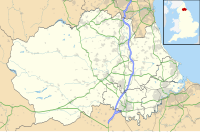Bowes Castle
| Bowes Castle | |
|---|---|
| Bowes, County Durham, England | |

Keep of Bowes Castle
|
|
| Coordinates | 54°31′00″N 2°00′50″W / 54.5168°N 2.0139°WCoordinates: 54°31′00″N 2°00′50″W / 54.5168°N 2.0139°W |
| Grid reference | grid reference NY992135 |
| Site information | |
| Owner | English Heritage |
| Open to the public |
Yes |
| Site history | |
| Materials | Stone |
| Events | Great Revolt of 1173-74 |
Bowes Castle was a medieval castle in the village of Bowes in County Durham, England. Built within the perimeter of the former Roman fort of Lavatrae, the early timber castle on the site was replaced by a more substantial stone structure between 1170 and 1174 on the orders of Henry II. A planned village was built alongside the castle. Bowes Castle withstood Scottish attack during the Great Revolt of 1173-74 but was successfully looted by rebels in 1322. The castle went into decline and was largely dismantled after the English Civil War. The ruins are now owned by English Heritage and run as a tourist attraction.
Bowes Castle was built within the ruins of the Roman fort of Lavatrae. The route was one of the few upland passes to link England and Scotland and had remained strategically important during the medieval period. The castle site lay within the Honour of Richmond, a grouping of lands traditionally owned by the Counts of Brittany during the early medieval period, but the land itself was a demesne estate, owned by the Crown.
Around 1136, Alan de Bretagne, the Count of Brittany, built a timber castle in the north-west corner of the old fort. The use made of the older Roman fortification at Bowes was similar to that at the nearby castles of Brough and Malton. This castle was inherited by his son, Conan, and when he in turn died in 1171, it was claimed by Henry II.
...
Wikipedia

